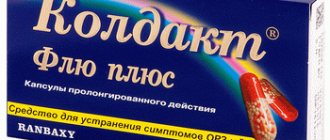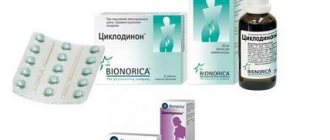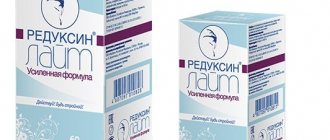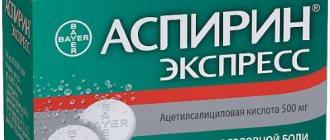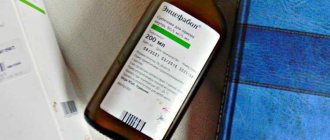The cold season is a period of increased risk of contracting respiratory viral infections. Not all people have enough time to stay at home and receive treatment for 5-8 days. Everyone wants to recover quickly, avoid complications, and quickly get rid of catarrhal symptoms. Coldact Flu Plus comes to their aid.
This drug, which combines several active ingredients, effectively copes with most unpleasant symptoms. Whether Coldact Flu Plus is an antibiotic or not, people taking it worry. According to the manufacturer, the medication does not belong to the group of antibacterial agents.
Release form and composition
Coldact Flu Plus is available in the following dosage forms:
- extended-release capsules: hard gelatin, size No. 0, with a transparent body and a red cap; contents – pellets of white or almost white, yellow, orange and almost red colors (10 pcs. in blisters, 1 or 10 blisters in a cardboard package);
- suspension for oral administration: orange liquid with a characteristic odor (60 ml in dark glass bottles, 1 bottle in a cardboard package with a measuring spoon included).
Each pack also contains instructions for using Coldact Flu Plus.
Composition per 1 capsule of prolonged action:
- active ingredients: paracetamol – 200 mg, phenylephrine hydrochloride – 25 mg, chlorphenamine maleate – 8 mg;
- excipients: ethylcellulose, povidone, talc, diethyl phthalate, sodium disulfite, talc, disodium edetate, hypromellose, microcrystalline cellulose, Ponceau 4R crimson dye, isopropanol, sunset yellow dye, starch syrup, sucrose, quinoline yellow dye, purified water;
- capsule body and cap: methyl parahydroxybenzoate, propyl parahydroxybenzoate, gelatin, Ponceau 4R crimson dye, azorubine dye, purified water.
Composition per 5 ml oral suspension:
- active ingredients: paracetamol – 125 mg, phenylephrine hydrochloride – 5 mg, chlorphenamine maleate – 2 mg;
- excipients: sodium saccharinate, sodium chloride, carmellose sodium, glycerol, polysorbate, sodium citrate, propyl parahydroxybenzoate, methyl parahydroxybenzoate, disodium edetate, sucrose, xanthan gum, colloidal silicon dioxide, citric acid, sunset yellow dye, microcrystalline cellulose, raspberry flavoring 502700С, purified water, pineapple flavoring 503092С, orange flavoring 051941СS
Taken together with other drugs
The likelihood of an overdose with Coldact Plus (the instructions confirm this) increases when taken together with bambiturates, Diphenin, Carbamazepine, Rifampicin, as well as Zidovucin and other drugs that are inducers of liver enzymes.
The effect of the drug “Koldakt” is enhanced by the simultaneous use of sedatives, ethanol, and various groups of monoamine oxidase inhibitors.
The simultaneous use of antidepressants can cause fluid retention in the human body, dry mouth and lead to constipation. Glucocorticosteroid drugs increase the likelihood of developing glaucoma.
Paracetamol significantly reduces the effectiveness of uricosuric drugs.
Chlorphenamine in the composition of the drug and when combined with drugs containing furazodide provokes the manifestation of a hypertensive crisis, excessive excitability and hyperpyrexia.
Tricyclic psychotropic drugs significantly increase the effect of phenylephrine, and in combination with halothane can lead to ventricular arrhythmia. They reduce the effect of guanethidine, which in turn increases the α-andrenostimulation of phenylephrine.
What other consequences can long-term use of this medicine cause? Coldact Flu Plus can cause the anticoagulant effect of warfarin and other drugs of the coumarin group, and also increases the risk of various types of bleeding.
Pharmacological properties
Pharmacodynamics
Coldact Flu Plus is a long-acting combination product, the therapeutic effect of which is due to the properties of its individual components:
- paracetamol: an anilide with antipyretic and analgesic activity;
- phenylephrine hydrochloride: an alpha-adrenergic agonist that has a vasoconstrictor effect, reducing hyperemia and swelling of the mucous membrane of the nasal cavity and paranasal sinuses;
- chlorphenamine maleate: is a blocker of H1-histamine receptors, which has antiallergic activity, eliminates lacrimation, reduces the severity of local exudative effects, and relieves itching in the nose and eyes.
Pharmacokinetics
The pharmacokinetics of Coldact Flu Plus have not been described.
pharmachologic effect
The pharmacological action and pharmacodynamics of this medication are clearly reflected in the instructions that come with it.
The therapeutic effect of the drug is achieved due to the active work of the substances included in its composition:
- chlorphenamine has a pronounced effect against allergic reactions, the antihistamine reduces the severity of profuse lacrimation, burning and itching in the eyes, as well as in the nasal cavity;
- paracetamol, which belongs to the category of non-steroidal anti-inflammatory drugs, has several effects at once: it reduces the increased body temperature to physiologically correct parameters, relieves severe pain - head, joints, muscles, reduces the manifestations of a feverish state, and to a small extent reduces inflammatory foci;
- phenylephrine, a substance that has a pronounced local effect aimed at narrowing the vascular lumen. Thanks to phenylephrine, a decrease in swelling of the nasal tissues and hyperemia of the mucous membrane of the upper respiratory tract is achieved, in addition, a beneficial effect is also observed in the paranasal sinuses.
Contraindications
Absolute:
- severe kidney, liver, bladder and/or heart disease;
- high blood pressure;
- severe atherosclerosis of the coronary arteries;
- peptic ulcer of the duodenum and stomach;
- diabetes;
- pancreatic diseases;
- diseases of the blood system;
- difficulty urinating with prostate adenoma;
- thyrotoxicosis;
- glucose-6-phosphate dehydrogenase deficiency;
- closed-angle form of glaucoma;
- children under 6 years of age (for suspension);
- children under 12 years of age (for capsules);
- pregnancy period;
- breastfeeding period;
- hypersensitivity to the main or auxiliary components of the drug.
Relative (Coldact Flu Plus is used with caution):
- chronic obstructive pulmonary disease;
- bronchial asthma;
- renal and/or liver failure of mild or moderate severity;
- congenital hyperbilirubinemia (Dubin-Johnson syndrome, Gilbert syndrome, Rotor syndrome).
During pregnancy and lactation
Coldact Flu Plus tablets are not approved for use during pregnancy and breastfeeding. For a young mother, to get rid of unpleasant catarrhal symptoms, it is preferable to use one-component formulations. To reduce body temperature you need to take Paracetamol in the dosage recommended by your doctor. To reduce swelling of the nasal passages, you should rinse your nose with saline solution and drip vasoconstrictor drops (Otrivin, Nazivin). To get rid of other unpleasant symptoms, you can use traditional medicine methods.
Treatment of acute respiratory viral infections should not be carried out independently. When the first signs of a cold appear, a person should immediately seek advice from a specialist.
Coldact Flu Plus: instructions for use (dosage and method)
Coldact Flu Plus is taken orally. Capsules should be swallowed whole with water. The suspension must be shaken before use.
The recommended dose for children over 12 years of age and adults is one capsule 2 times a day (every 12 hours) or two teaspoons (10 ml) of suspension 3-4 times a day. Children aged 6 to 12 years can be given the drug only in the form of a suspension in a dose of one teaspoon (5 ml) 3-4 times a day.
Coldact Flu Plus can be taken as an antipyretic for no more than 3 days, and as an analgesic - for no more than 5 days.
Analogues of the drug
To get rid of the symptoms of colds and acute respiratory viral infections, you can use not only Coldact Flu Plus, its analogues also give good results.
Based on the content of active ingredients, Antiflu and Theraflu Extra are distinguished.
Based on the similarity of effects, the following drugs are noted: Grippstad, Antiflu Kids, Maxicold, Fervex, Coldrex Hot Rem, Gripend Hot Active, Theraflu, Flustop.
Among the effervescent tablets, there are several that have a similar effect: Antigrippin, Efferalgan, Padevix, Apap S Plus.
Separately, it is necessary to note tablets that can perform some of the functions inherent in Coldact Flu Plus:
- No-shpa;
- Gevadal;
- Pentalgin;
- Panadol;
- Rinza;
- Caffetin;
- Solpadeine;
- Femizol;
- Migrenol;
- Novalgin;
- Rankoff;
- Coldrex.
Capsules with a similar therapeutic effect: Toff plus, Grippostad S, Solpadeine.
A suspension similar in its action to Coldact Flu Plus is called Daleron.
Among the syrups noted:
- Panadol;
- Flucoldex;
- Paracetamol.
On pharmacy shelves you can find rectal suppositories that have an effect similar to that given by Coldact Flu Plus: Panadol, Cefekon D.
For infusions, Ifimol and Perfalgan solutions are used.
When choosing a remedy to get rid of the negative symptoms of ARVI, the question may arise - Koldakt or Theraflu, which is better? A comparative analysis of these two drugs provides the following information:
- Coldact Flu Plus contains a smaller amount of paracetamol than Theraflu;
- Theraflu is manufactured in India;
- the price of Coldact Flu Plus is lower than the cost of Theraflu.
Side effects
- gastrointestinal tract and hepatobiliary system: dry mouth, nausea, stomach pain, vomiting, diarrhea, hepatitis, dose-dependent liver failure, increased activity of liver enzymes, liver necrosis (including fatal), cirrhosis and fibrosis of the liver ( with prolonged unjustified use, sometimes with fatal consequences);
- cardiovascular system: increased blood pressure, palpitations;
- respiratory system: exacerbation of bronchial asthma or bronchospasm, including in patients with hypersensitivity to acetylsalicylic acid or other non-steroidal anti-inflammatory drugs;
- central nervous system: increased excitability (especially in childhood), drowsiness, feeling of fatigue, dizziness, sleep disturbance, decreased speed of psychomotor reactions;
- urinary system: urinary retention, nephrotoxic effect (in case of long-term use of large doses);
- hematopoietic system: leukopenia, anemia, agranulocytosis, thrombocytopenia, hemolytic anemia, pancytopenia, thrombocytopenic purpura, methemoglobinemia;
- immune system: urticaria, skin itching, rash, angioedema, polymorphobullous erythema, toxic epidermal necrolysis, anaphylactic shock, acute generalized exanthematous pustulosis;
- other reactions: increased intraocular pressure, pupil dilation, accommodation paresis.
Overdose
Symptoms of an overdose of Coldact Flu Plus are mainly caused by paracetamol and begin to appear after taking more than 10-15 g of paracetamol.
Paracetamol
In case of acute overdose, hepatotoxic effects, including liver necrosis, are observed. It is also possible to develop nephropathy with irreversible liver failure.
The severity of an overdose directly depends on the dose, so patients should be warned about the prohibition of simultaneous use of several drugs containing paracetamol. The risk of poisoning is especially high in children, the elderly, patients with liver disease, patients with chronic malnutrition, persons with chronic alcoholism and patients concomitantly taking inducers of microsomal oxidation in the liver. Paracetamol intoxication can cause bleeding, impaired glucose metabolism, pancreatitis, hypoglycemia, encephalopathy, liver failure, coma and even death.
In the first 24 hours after an overdose of paracetamol, nausea, pale skin, vomiting, convulsions and anorexia are observed. Abdominal pain may be the first sign of liver damage and usually does not appear for 1–2 days, and sometimes may appear later, after 4–6 days. On average, abdominal pain occurs 72–96 hours after an overdose. It is also possible to develop metabolic acidosis and impaired glucose metabolism, the appearance of acute renal failure and acute tubular necrosis. Cases of pancreatitis and cardiac arrhythmia have been reported.
As an antidote, the patient is administered acetylcysteine (orally or intravenously). The patient's stomach is washed and methionine is given. These measures may have an effect within 48 hours after an overdose of paracetamol. It is recommended to take activated carbon. It is advisable to monitor blood circulation and respiration. Possible convulsions are relieved with diazepam.
Phenylephrine
In case of an overdose of phenylephrine, the following symptoms occur: nausea, vomiting, dizziness, headache, decrease or increase in blood pressure, hematopoietic disorders, rash, drowsiness with subsequent anxiety (especially in children), insomnia, increased excitability, bradycardia, visual disturbances, convulsions. , coma.
Treatment consists of surgical gastric lavage and prescribing the necessary symptomatic and supportive therapy. The hypotensive effect can be stopped by intravenous administration of an alpha-receptor blocker. For convulsions, diazepam is prescribed.
Chlorphenamine
Signs of chlorphenamine overdose include: drowsiness, anticholinergic effects, convulsions, dystonic reactions, arrhythmia, cardiovascular collapse, respiratory arrest. Children may also experience agitation, behavior changes, incoordination, tremors, seizures, hallucinations and anticholinergic effects.
It is necessary to induce vomiting, and in case of massive overdose, rinse the stomach. The patient may then be given activated charcoal and a laxative to slow the absorption of chlorphenamine. Seizures are treated with intravenous phenytoin or diazepam. In severe cases, hemoperfusion is performed.
Drug overdose
With prolonged use of the medicine, an overdose may occur, which in most cases is due to taking large doses of paracetamol, which is part of Coldact Flu Plus. Reviews say that when consuming more than 10-14 g, pale skin, sleep and appetite disturbances, nausea, and a gag reflex may appear. The thrombosed period increases. The activity of liver transaminases also increases. Hepatonecrosis, liver failure, and pain in the stomach area arise and develop.
The most serious consequence of overdose is liver failure, which often leads to encephalopathy, turbulence necrosis, and metabolic acidosis. Swelling of the brain of the head is provoked and, as a result, death. Persons who combine consumption of alcoholic beverages and taking capsules may suffer serious liver damage.
In case of overdose of the drug, gastric lavage is prescribed every six hours. It is recommended that SH-group donors take eight hours after consuming the Coldact Flu Plus medication. The instructions state that N-acetylcesteine is administered no later than 12 hours before taking the last dose of the medicine.
In any case, if you overdose on a drug, you should not prescribe treatment yourself, but rather call a specialist immediately.
special instructions
Coldact Flu Plus is not recommended for use without a doctor's prescription in patients who are being treated with other medications, in particular monoamine oxidase inhibitors. The drug cannot be combined with other paracetamol-containing drugs and alcohol. While using Coldact Flu Plus, it is not advisable to use tranquilizers, psychotropic and hypnotics.
If fever persists or repeated increases in temperature while taking the drug, you should consult a doctor. Pain that persists for more than 5 days is also a reason to consult a specialist.
In patients who take Coldact Flu Plus for a long time, it is necessary to monitor liver function and peripheral blood counts.
Coldact Flu Plus distorts the results of laboratory tests when determining uric acid and glucose in blood plasma.
Patients with alcoholic hepatosis have an increased risk of liver damage.
Impact on the ability to drive vehicles and complex mechanisms
During treatment, patients should refrain from any activities that require a high concentration of attention and rapid motor reaction, since Coldact Flu Plus can cause drowsiness, dizziness and a decrease in the speed of psychomotor reactions.
Indications for use
The question, Coldact Flu Plus, whether children can take it during treatment for ARVI, comes up quite often. This drug quite effectively fights unpleasant cold symptoms, eliminating upper respiratory tract infections.
What does the drug help with? When should and can you take Koldakt? This medication is used for the symptomatic treatment of viral diseases, including influenza, adenovirus, rhinovirus infections, and parainfluenza. The medicine immediately eliminates a whole complex of catarrhal symptoms:
- nasal discharge and congestion;
- feverish condition;
- pain syndrome in different areas of localization;
- reducing the severity of inflammation;
- fight against viruses;
- getting rid of other signs of pathological processes resulting from viral infection, influenza, and colds.
Indications for use of Coldact Flu Plus include the treatment of inflammatory diseases of the upper respiratory tract: sinusitis, sinusitis, tonsillitis, otitis, bronchitis, allergic or acute rhinitis.
Despite the wide range of indications for which this medication should be used, its use without prior medical consultation is not allowed. Some cases when a bacterial infection joins an existing viral one may require treatment using antibacterial drugs.
Drug interactions
Possible drug interactions due to the content of paracetamol in Coldact Flu Plus:
- sedatives, monoamine oxidase inhibitors, ethanol: the effects of these drugs are enhanced;
- warfarin and other coumarins: it is possible to increase anticoagulant properties and increase the risk of bleeding (with long-term regular use of paracetamol);
- phenytoin, carbamazepine, barbiturates, zidovudine, rifampicin, phenobarbital, isoniazid and other inducers of microsomal liver enzymes: increase the possible hepatotoxicity of paracetamol;
- metoclopramide: the rate of absorption and plasma concentration of paracetamol increases;
- Domperidone: may increase the rate of absorption of paracetamol;
- lamotrigine: the bioavailability and therapeutic effect of lamotrigine may be reduced due to the induction of its metabolism in the liver;
- Chloramphenicol: the half-life of chloramphenicol may be increased;
- cholestyramine: there is a decrease in the absorption of paracetamol (it is recommended to maintain an interval of 1 hour between taking these drugs);
- probenecid: the metabolism of paracetamol changes, its dose should be reduced;
- zidovudine: possible development of neutropenia and an increased risk of liver damage (with regular use simultaneously with paracetamol);
- ethanol: the hepatotoxicity of paracetamol may be enhanced;
- uricosuric drugs: the effectiveness of uricosuric drugs is reduced.
Drug interactions that are caused by the content of phenylephrine in Coldact Flu Plus:
- monoamine oxidase inhibitors: their therapeutic effect may be enhanced and a hypertensive crisis may develop (this combination is contraindicated);
- tricyclic antidepressants, sympathomimetic drugs: the likelihood of side effects from the cardiovascular system may increase;
- beta-blockers and other antihypertensive drugs (reserpine, debrisoquine, methyldopa, guanethidine, etc.): the effectiveness of these drugs may decrease and, as a result, increase blood pressure, as well as the occurrence of other cardiovascular adverse reactions;
- digoxin and other cardiac glycosides: the risk of arrhythmia and/or myocardial infarction increases;
- Ergot alkaloids (methysergide, ergotamine): the likelihood of poisoning from ergot alkaloids increases.
Chlorphenamine, the third active component of Coldact Flu Plus, may result in the following types of drug interactions:
- opioid analgesics, antidepressants, anticonvulsants, anxiolytics, ethanol and other central nervous system depressants, antipsychotic and antiemetic drugs, hypnotics and other antihistamines: the effects of these drugs may be enhanced;
- phenytoin: suppression of phenytoin metabolism and development of its toxicity may occur;
- furazolidone: possible agitation, increased appetite and hypertensive crisis;
- anticholinergic drugs (atropine, drugs for urinary incontinence, some psychotropic drugs): it is possible to enhance the effects of these drugs and cause tachycardia, disorders of the digestive system (colic), dry mouth, headache and urinary retention.
Pharmacodynamics and pharmacokinetics
The composition of Coldact Flu Plus capsules and suspensions includes chlorpheniramine; it is this component that has a pronounced antihistamine effect on the body. It reduces the effect on H1 receptors, resulting in a not too pronounced, but noticeable sedative and antimuscarinic effect.
Chlorpheniramine reduces the permeability of the cellular structure of the nasal mucosa, which immediately manifests itself in a reduction in such unpleasant catarrhal symptoms as swelling and itching.
The penetration of the active ingredients of the drug into the blood plasma is not very active. Their highest concentration is observed in serum within two to six hours. Part of the drug is then excreted through the urinary system, while the other undergoes metabolization processes.
We recommend reading: Ibuklin for children
The next component of Coldact Flu Plus belongs to the category of symptomimetics. Phenylpropanolamine acts on alpha type adrenergic receptors. This allows you to achieve several positive effects in the nasal cavity, nasal mucosa and paranasal sinuses:
- vasoconstriction;
- removal of puffiness;
- reduction in the amount of discharge.
The maximum of phenylpropanolamine is observed in the blood within 120 minutes after it is taken orally, and this substance is excreted through the kidneys.
The last component of Coldact Flu Plus, paracetamol, which reduces elevated body temperature and relieves various types of pain, does not bind too well to blood proteins. It is metabolized through the functioning of the liver.
Reviews of Coldact Flu Plus
In reviews of Coldact Flu Plus, patients share their positive experience of using this drug during ARVI, influenza and other colds. The drug quickly reduces temperature, eliminates pain, reduces runny nose and lacrimation, and makes breathing easier. The effect is prolonged and lasts up to 12 hours. The capsules are convenient to take, the daily dose is only 2 capsules in two doses. Coldact Flu Plus is available without a prescription and has a relatively low cost.
The disadvantages of the product include possible side effects. Thus, patients complained of dizziness, lack of attention, drowsiness, and lethargy. Coldact Flu Plus does not eliminate cough. There is also a fairly large list of contraindications for its use.
Interaction
Coldact Flu Plus requires careful use if a person is simultaneously forced to use other pharmaceuticals.
The interaction of different types of drugs can give an effect opposite to the expected one, or increase the degree of exposure of the drugs to the body.
How does taking Coldact Flu Plus affect other medications and their effects on the body?
- Taken together with guanethidine enhances its hypotensive effect on blood pressure.
- Strengthening the effects of monoamine oxidase inhibitors, sedatives and ethanol.
- Paracetamol has the ability to reduce the therapeutic effects of urizosuric drugs.
- Simultaneous use of Coldact Flu Plus with antidepressants (tricyclic type) or guanethidine provokes an increase in alpha adrenergic stimulating effects, which gives phenylephrine.
When a person simultaneously drinks Coldact Flu Plus with other medications, the negative effects of the medications may increase:
- with halothane – increased severity of ventricular arrhythmia;
- with phenothiazine derivatives, antidepressants, antipsychotic drugs, antiparksonics: the appearance of dry mouth, urine retention, development of digestive dysfunction in the form of constipation;
- with glucocorticosteroids: increased risk of glaucoma;
- with furazolidone: increased agitation, danger of hypertensive crisis, hyperpyrexia;
- with rifampicin, carbamazepine, barbiturates, diphenin, zidovudine, and other drugs used to induce microsomal liver enzymes: increased hepatoxic effects of paracetamol on the liver.
We recommend reading: Folk remedies for the flu
When planning to fight respiratory viral diseases by taking Coldact Flu Plus, it is important to carefully read the instructions supplied with the drug to learn the important instructions.
- When the drug is used in conjunction with other medications, even from other pharmacological groups, the risk of their negative interaction increases, which should be reported to the doctor at the time of prescribing this medication.
- The use of suspensions or capsules requires temporarily stopping taking tranquilizers and medications that have a pronounced hypnotic effect.
- Coldact Flu Plus treatment can make changes in tests showing blood glucose levels, as well as plasma uric acid levels.
- Long-term use of the drug requires monitoring of liver and blood parameters through certain tests.
- During the period of drug therapy, you do not need to take up work that requires a quick reaction (for example, driving a vehicle, working with complex mechanisms and machines).
Despite the fact that you can purchase the drug at a pharmacy without necessarily presenting a prescription from a doctor, if you have any doubts about the possibility of using it, you should seek medical advice.
